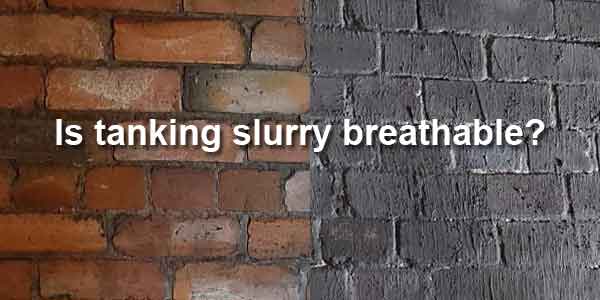The DIY Fix is reader supported. When you buy after clicking a link on our site, we may earn an affiliate commission.
When damp is penetrating a property, there are many different potential solutions. The one you choose, can rely on several factors.
One thing you may consider, especially in older buildings, is whether you would like it to be breathable. Most older buildings are originally designed with lime mortars and plasters, as well as other materials designed to breathe. Applying non breathable damp solutions in this situation can cause problems.

However, in more modern properties a completely non breathable waterproof system may be the best solution.
Tanking slurry is a great example of a non-breathable waterproofing system, that is extremely popular. It is very good at stopping penetrating damp and very affordable.
Tanking slurry is a cementitious compound made from Portland cement, aggregates, quartz sand, and various chemicals. This combination is designed to stop water ingress. Once dry, the slurry forms a completely watertight surface.
The surface is none breathable, which means that nothing can pass through it.
Main Advantage of Tanking Slurry
Very good at protecting against penetrating damp
The main advantage of a tanking slurry is its ability to completely seal surfaces suffering from penetrating damp.
When the slurry is applied, it forms a waterproof coating over the surface. It also enters any small cracks and capillaries. Once beneath the surface, moisture and free lime causes the slurry to form insoluble crystals, which block the capillaries, and any other gaps and cracks, that moisture may pass through.
Once the surface is completely dry and the crystals have formed, a fully waterproof non breathable layer is created. This will completely stop penetrating damp.
Low-cost tanking solution
Tanking can be an expensive job and there are several ways it can be achieved. Two of the most popular, simple solutions are damp proof membranes and tanking slurry.
Both methods can work well and will both provide a watertight non-breathable surface. However, of the two, tanking slurry is the easiest to apply and it is usually the cheaper option.
It also requires zero skill. If you can read the instructions on the tub, you shouldn’t have any problems. A membrane on the other hand is a little more technical.
Disadvantage of tanking slurry being non breathable
There are some disadvantages to tanking slurry not being breathable. The main problems this can cause are:
Disadvantage 1 – Condensation
Slurry is more commonly used in areas such as basements, garages, and stone/brick sheds. The surfaces in these structures can often be quite cold. For example, a stone shed, or garage could be a single skin of bricks, with no insulation.
Also, a basement is generally not well insulated and may not be well ventilated either.
This means that the surfaces can be quite cold and there could be excess moisture present in the air. Once a slurry is added it will not help the surface to warm up at all, but it will stop moisture penetrating the internal surface.
Due to the walls being so cold, they are likely to act as a dew point and condensation will be drawn to them. However, instead of entering the surface the moisture will collect on the slurry as condensation.
Disadvantage 2 – Forms a poor surface to adhere to
Due to tanking slurry being non breathable and impenetrable to liquid, it can be difficult to apply finishes over the top. This could include things like, plasters and paints to provide a better finish.
It could also affect the way you add things like plaster boards. If you were planning to dot and dab over tanking slurry, then you may need to try a different adhesive that is not water based.
Even though it is not the best surface for adding finishes too, there are workarounds. Most of the above will work providing a suitable bonding compound is applied prior to application.
Disadvantage 3 – You could trap moisture
The advantage with a breathable building surface is it will not trap water inside. For example, in a brick wall using an old lime mortar moisture may permeate beneath the surface, but the moisture will be free to leave the surface and evaporate.
With a non-breathable product such as tanking slurry this is not possible. If your slurry over damp it could be trapped behind the surface.
Trapped damp could lead to future issues. For example, it could find a way around the tanking and enter the property via another route.
Die to this, it is always advised to solve the main issue causing penetrating damp before using slurry. This will usually mean fixing an external issue that is allowing water in.
Conclusion
In conclusion tanking slurry is a fantastic product, but it is not breathable. Therefore, if you would like to keep the surface you are damp proofing breathable, then a slurry may not be your best choice.
If you re not sure what the best solution is, then it is usually good to get an expert’s opinion. Most damp companies will provide a free damp survey, which will identify the best course of action.
Finding a good local damp company is also quite easy. Especially if you use online tools, such as job comparison sites. Most companies using these sites will offer a free survey and because they are competing with other companies, prices tend to be much cheaper.
Also, you can read reviews from previous customers and see the jobs they have done in the past.



